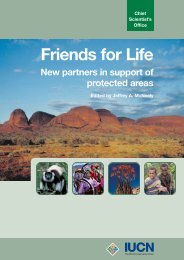Dolphins, Whales and Porpoises: 2002-2010 Conservation - IUCN
Dolphins, Whales and Porpoises: 2002-2010 Conservation - IUCN
Dolphins, Whales and Porpoises: 2002-2010 Conservation - IUCN
You also want an ePaper? Increase the reach of your titles
YUMPU automatically turns print PDFs into web optimized ePapers that Google loves.
Protected Areas <strong>and</strong> Mediterranean Biodiversity, <strong>and</strong> the<br />
CMS agreement on conservation of Mediterranean <strong>and</strong><br />
Black Sea cetaceans mentioned in earlier chapters), little<br />
progress has been made toward underst<strong>and</strong>ing the causes of<br />
the short-beaked common dolphin’s regional decline; <strong>and</strong><br />
no concrete measures have been taken to arrest <strong>and</strong> reverse<br />
this trend.<br />
Contamination by xenobiotics, such as PCBs, <strong>and</strong> a decrease<br />
in prey quality or availability have been implicated in<br />
the common dolphin’s regional decline (Bearzi 2001; Politi<br />
<strong>and</strong> Bearzi in press; Fossi et al. in press). Indeed, it is<br />
possible that these factors have been acting synergistically,<br />
with the poor nutritional status of individuals prompting the<br />
mobilization of lipophilic contaminants that would otherwise<br />
be “stored” in their blubber. However, the relative<br />
importance of these <strong>and</strong> other factors is not understood, <strong>and</strong><br />
it is therefore difficult to design <strong>and</strong> implement mitigation<br />
measures. Bycatch <strong>and</strong> intentional killing may have had an<br />
impact in some areas (e.g., Silvani et al. 1999), but these<br />
factors do not seem to have played a significant role in some<br />
of the Mediterranean areas where common dolphins have<br />
declined (e.g., in the northern Adriatic Sea)(Bearzi <strong>and</strong><br />
Notarbartolo di Sciara 1995; Bearzi et al. 2001). Although<br />
the Mediterranean Sea represents less than 1% of the<br />
planet’s water surface area, it hosts 15% of all commercial<br />
traffic <strong>and</strong> 30% of all hydrocarbon ship commerce. The<br />
impacts of overfishing <strong>and</strong> chemical pollution in the<br />
Mediterranean are extensive <strong>and</strong> relatively well document-<br />
90<br />
ed (e.g., Stanners <strong>and</strong> Bourdeau 1995; FAO 1997; EAA/<br />
UNEP 2000).<br />
Remaining issues: No specific management measures<br />
have been taken to protect the few remaining groups of<br />
common dolphins in the central <strong>and</strong> eastern Mediterranean<br />
even though it is well known that they are exposed to direct<br />
disturbance by vessel traffic, bycatch in fishing gear, <strong>and</strong><br />
habitat degradation (e.g., chemical pollution, possibly prey<br />
depletion). Although the lack of scientific information is a<br />
serious problem in attempting to pinpoint <strong>and</strong> address specific<br />
threats, it does not justify continued inaction.<br />
<strong>Conservation</strong> recommendations: In addition to stressing<br />
the importance of more research (Project 47, Chapter 5), the<br />
CSG recommends that a small number of pilot conservation<br />
<strong>and</strong> management projects be implemented immediately<br />
in selected areas where relict groups of common<br />
dolphins are known to reside. Two such areas could be<br />
waters adjacent to the isl<strong>and</strong> of Kalamos in Greece, <strong>and</strong> near<br />
the isl<strong>and</strong> of Ischia in Italy. Both areas are known to provide<br />
critical habitat for small populations of common dolphins.<br />
The dolphins around Kalamos have declined dramatically<br />
within the past eight years (Politi <strong>and</strong> Bearzi in press). The<br />
immediate establishment of protected areas should be accompanied<br />
by experimental management plans that include<br />
intensive monitoring of the dolphins, restrictions on vessel<br />
traffic <strong>and</strong> fishing activity, education efforts directed at the<br />
local fishing communities <strong>and</strong> recreational users, <strong>and</strong><br />
focused research.






